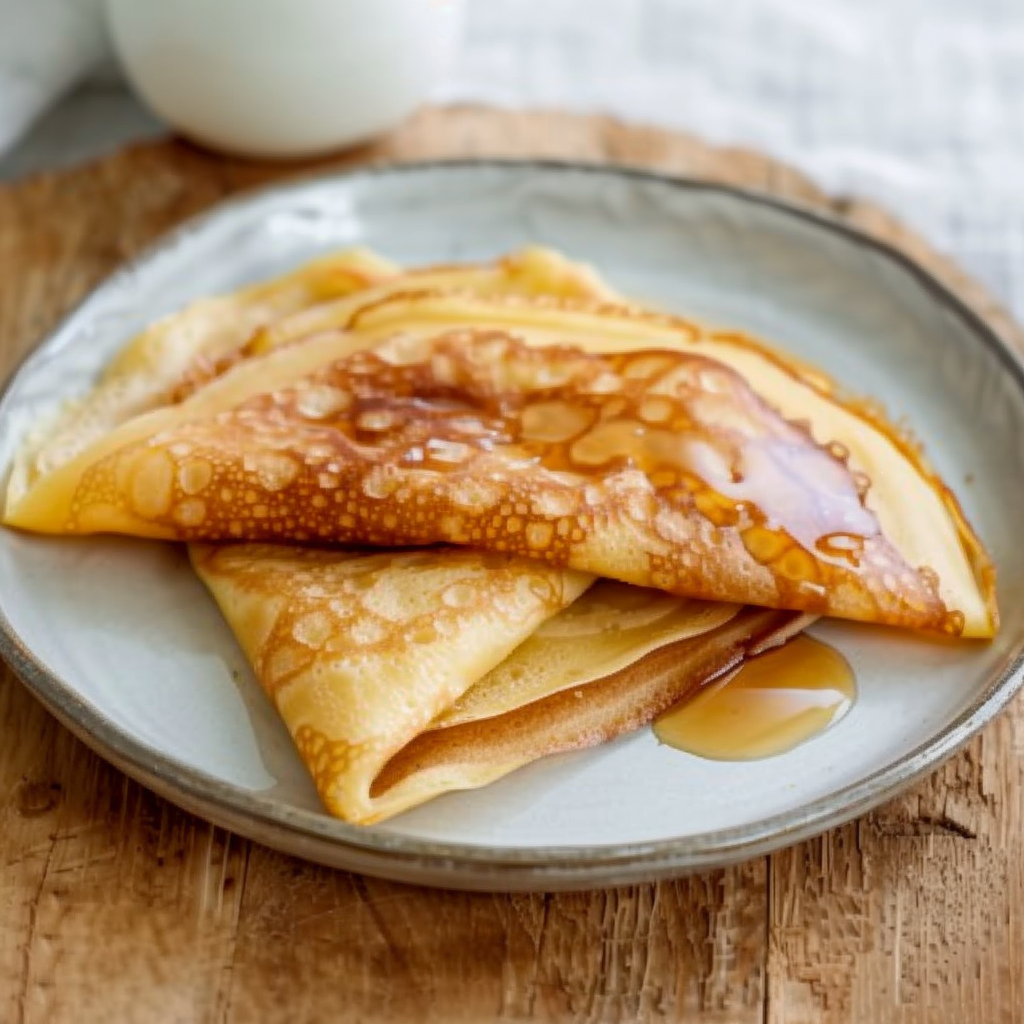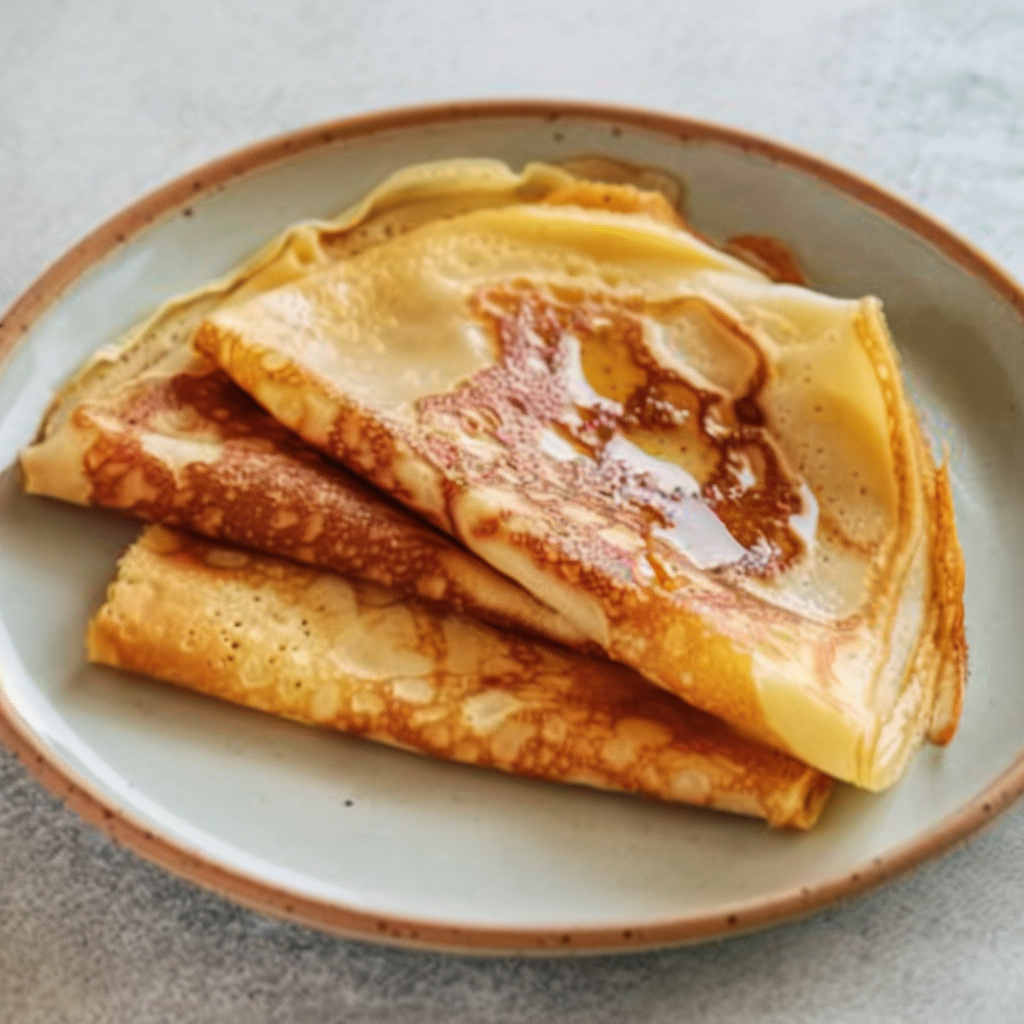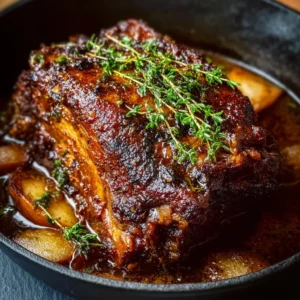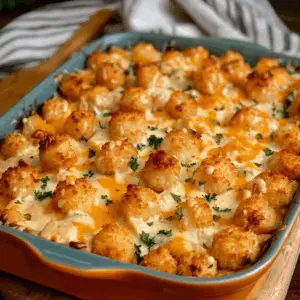1.Classic French Crepes
Few dishes in the culinary world blend elegance and simplicity like the classic French crepe. With origins rooted in the Brittany region of France, crepes have become a beloved staple around the world. Whether served at a street vendor in Paris or made at home in your kitchen, these paper-thin pancakes offer an unmatched versatility.
What sets crepes apart from typical pancakes is their delicate texture and flexible form. Unlike thicker American-style pancakes, crepes are thin, tender, and slightly crisp at the edges. They can be filled, rolled, folded, or stacked, making them the ideal base for a wide variety of dishes. In fact, crepes are so integral to French cuisine that they’ve earned their own holiday: La Chandeleur, a day dedicated to crepe-making and celebration.
Part of what makes this classic French crepe recipe so popular is its adaptability. It transitions seamlessly from breakfast to dinner, and even into dessert. With a simple batter of flour, eggs, and milk, crepes become a canvas for both sweet and savory creations. For a bit of culinary history, you can explore the history of crepes, which illustrates their evolution from humble peasant food to gourmet fare.
One of the biggest advantages of learning how to make crepes is mastering a foundational skill in French cuisine. Like learning to make a basic roux or mastering the perfect omelet, crepes embody the art of technique. For those diving into more traditional cooking methods, the French cooking basics offer helpful context and insight into the culinary roots of dishes like these.
As you begin to explore this fast and flawless crepe recipe, you’ll see how easily it can be adjusted to suit your preferences. Whether you’re craving sweet fillings like strawberries and cream or leaning toward savory options like ham and cheese, this base recipe provides the flexibility to make it your own.
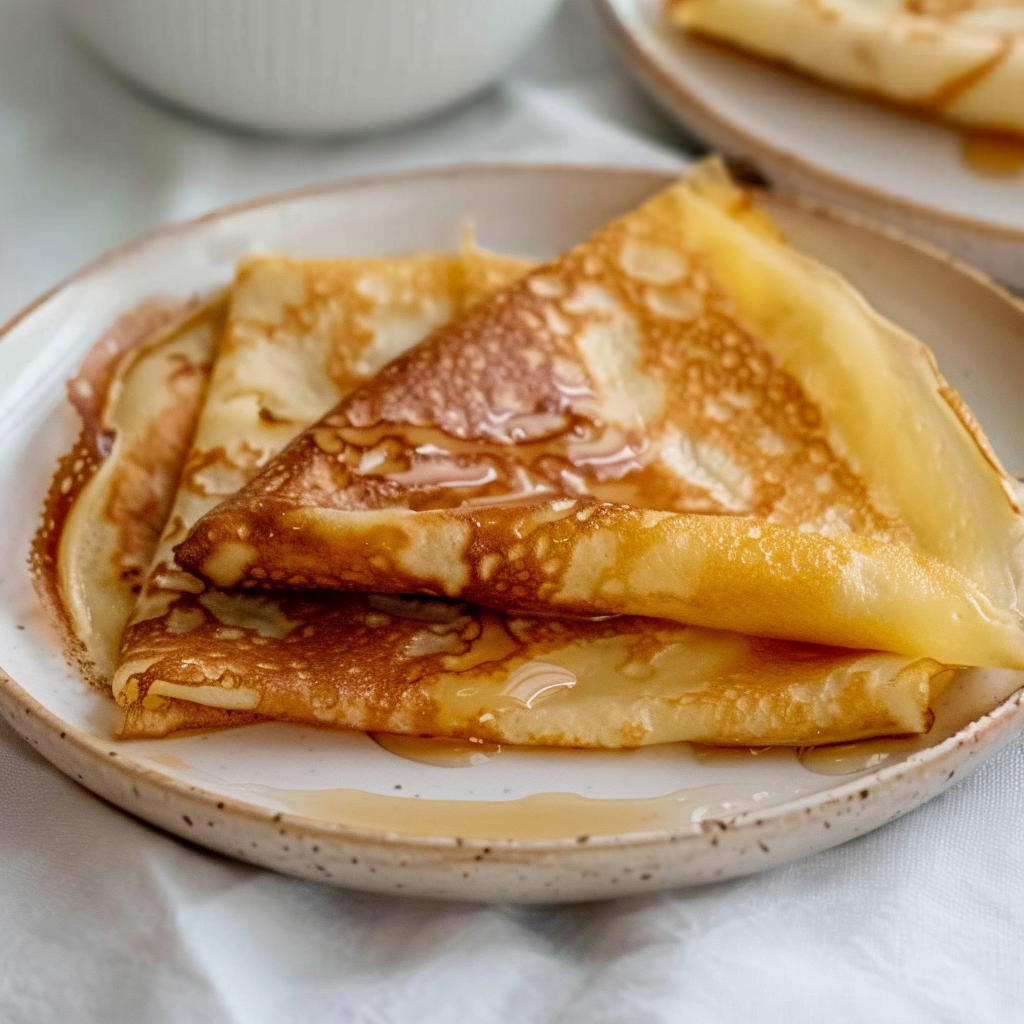
2. Why This is the Best Crepe Recipe
The beauty of this classic French crepe recipe lies in its perfect balance of simplicity, flavor, and texture. Unlike many complicated breakfast dishes, crepes require only a handful of ingredients and minimal equipment, yet the results are delightfully impressive. Each crepe turns out thin, tender, and delicately golden, making it the ideal base for both sweet and savory creations.
What makes this the best crepe recipe is its flawless consistency every time you prepare it. The combination of all-purpose flour, eggs, and milk ensures that the batter spreads smoothly in the pan and cooks evenly without tearing. Using melted butter in the batter adds richness and prevents sticking, while a small pinch of salt enhances the overall flavor profile. To understand more about why these ingredients work harmoniously, check out this detailed guide to all-purpose flour and the science behind its texture-building properties.
Another reason this crepe recipe stands out is its versatility. The same batter can easily be adapted into sweet or savory variations by simply adjusting the sugar content or changing the fillings. For example, a sprinkle of sugar makes the crepes perfect for desserts, while omitting it prepares them for savory dishes like mushroom and spinach crepes. You can explore additional inspiration for savory ideas on Pinterest’s crepe fillings page, where you’ll find dozens of creative combinations.
This recipe’s reliability also makes it ideal for beginners. There’s no need for specialized tools or a dedicated crepe pan—just a non-stick skillet and a gentle wrist motion. With practice, you’ll find yourself mastering the swirl that gives crepes their signature thinness. For more insight into the broader world of traditional French breakfasts, the classic French breakfast page offers a glimpse into how crepes fit into the morning table in France.
Ultimately, this fast and flawless crepe recipe offers everything a home cook could want: quick preparation, dependable results, and endless flavor possibilities. Once you’ve perfected the base, you’ll have a versatile staple that can transform from a light breakfast to an elegant dessert in minutes.
3. Ingredients Overview: What You’ll Need
Making homemade crepes starts with a short list of pantry staples. The magic of this easy crepe recipe is that it doesn’t require anything fancy — just basic ingredients that come together to create an incredibly versatile dish. Below is a breakdown of each component and its role in the recipe.
-
1 cup all-purpose flour
This is the structural base of the crepe. It gives the batter its body and helps the crepe hold together while remaining thin and pliable. For a deeper understanding of its role, explore the science behind all-purpose flour. -
2 large eggs
Eggs serve as the primary binding agent. They also contribute to the light texture and golden color of the crepes. You can learn more about the importance of eggs in cooking from this egg-based recipes guide. -
1 1/2 cups milk
Milk thins the batter and ensures that the crepes spread evenly. Whole milk is preferred for richness, but alternatives like oat or almond milk can be used for a dairy-free option. -
2 tablespoons melted butter
Melted butter adds richness to the batter and helps prevent sticking during cooking. Using quality butter is essential — find out more about how it enhances dishes in this cooking with butter resource. -
1 tablespoon sugar (optional)
This is added if you’re making sweet crepes. The sugar helps the crepes brown slightly and provides a mild sweetness. It’s completely optional if you prefer a savory version. -
1/4 teaspoon salt
A pinch of salt balances the flavors. Even in sweet crepes, salt brings out the depth of the batter. -
Butter or oil for the pan
You’ll need a small amount of butter or neutral oil to grease the pan between crepes. This keeps each one from sticking and gives the edges a slight crisp.
For those with dietary preferences, this recipe can easily be adapted:
-
Use gluten-free flour blends to make gluten-free crepes
-
Substitute almond milk and plant-based butter for a dairy-free or vegan version
-
Replace some of the flour with protein powder for high-protein crepes
Looking for creative ways to use these ingredients? The Nutella crepe inspiration board offers sweet and indulgent combinations that pair perfectly with this crepe base. Whether you stick to traditional fillings or get adventurous, this ingredient list ensures a strong foundation for perfect classic French crepes.
4. Tools & Equipment for Crepe Making
While making classic French crepes doesn’t require any fancy appliances, having the right tools can make the process smoother and the results more consistent. This section covers all the essentials and optional tools that can help elevate your homemade crepes to café-quality perfection.
Must-Have Tools
-
Mixing Bowl & Whisk
A large mixing bowl and a good whisk are essential for combining your ingredients smoothly. Whisking helps break up any lumps in the flour and ensures a uniform batter. -
Non-Stick Skillet or Crepe Pan
A non-stick skillet is the easiest and most accessible choice for most home kitchens. However, if you’re aiming for a more traditional experience, a crepe pan can help you achieve perfectly thin crepes with crisp, even edges. These pans are shallow and have low sides for easier flipping. -
Ladle or Measuring Cup
A ladle or ¼-cup measuring cup helps you pour the right amount of batter into the pan. This ensures consistency in thickness and size across all crepes. -
Spatula
A thin, flexible spatula is best for flipping crepes without tearing them. Silicone or offset spatulas work particularly well and can slide under the crepe with minimal resistance.
Optional Tools
-
Blender
For ultra-smooth batter, you can use a blender to mix the ingredients. This eliminates lumps and introduces a small amount of air, which can result in slightly lighter crepes. -
Cooling Rack
Placing cooked crepes on a wire rack prevents them from becoming soggy and allows excess steam to escape. -
Pastry Brush
A pastry brush can be used to apply a thin layer of melted butter or oil to the pan between crepes, keeping them from sticking without over-greasing.
Though many crepe recipes emphasize technique, tools can make the process more approachable — especially for beginners. If you’re new to French cooking, a dive into French cooking basics will help you understand how essential proper equipment is in achieving authentic results.
With just a few simple tools, you can master this fast and flawless crepe recipe in your own kitchen and be well on your way to creating sweet or savory masterpieces that rival any
5. Step-by-Step: How to Make Classic Crepes
Mastering the process of making classic French crepes is all about rhythm and attention to detail. This step-by-step method ensures your crepes will be thin, flexible, and delicately golden every time. Follow the directions closely, and soon it will become second nature.
Mix the Batter
-
Whisk together the dry and wet ingredients
In a large mixing bowl, combine 1 cup all-purpose flour with 2 large eggs. Begin whisking while gradually adding 1½ cups milk to prevent lumps. This gradual method is key to creating a smooth batter. -
Incorporate melted butter, sugar, and salt
Stir in 2 tablespoons of melted butter, 1 tablespoon sugar (if making sweet crepes), and ¼ teaspoon salt. Continue whisking until the batter is fully smooth and has no visible clumps. -
Let the batter rest
Allow the batter to rest for 15 to 30 minutes at room temperature. This rest period relaxes the gluten, resulting in more tender crepes. Some chefs prefer resting the batter overnight for even better texture. You can learn more about why resting matters in traditional cooking from this resource on French cuisine.
Cook the Crepes
-
Preheat and grease the pan
Heat a non-stick skillet or crepe pan over medium heat. Lightly grease it with butter or oil using a paper towel or pastry brush. Too much fat can cause the batter to slide instead of sticking evenly. -
Pour and swirl
Use a ¼-cup measuring cup to pour batter into the center of the pan. Immediately lift and tilt the pan in a circular motion to spread the batter into a thin, even layer. The thinner the better, but avoid holes. -
Cook the first side
Let the crepe cook for 1 to 2 minutes, or until the edges begin to lift and the bottom is golden. You’ll notice steam escaping and slight browning — a sign it’s time to flip. -
Flip and finish
Use a flexible spatula to gently flip the crepe. Cook the second side for another 30 seconds to 1 minute until lightly golden. Unlike the first side, the second doesn’t need long. -
Transfer and repeat
Slide the crepe onto a plate or wire rack. Lightly re-grease the pan and repeat with the remaining batter. Keep crepes warm by covering them with foil or a clean towel. For storage tips, check out this Pinterest crepe cake idea which shows how you can repurpose stacked crepes into layered desserts later.
If the batter spreads too thick or the crepes tear, the issue might be batter consistency or pan temperature. Adjust as needed — a thinner batter and a properly heated pan will give you the best results. You can also check the galette (buckwheat crepe) page for tips on working with alternative flours and crepe types.
By following these steps, you’ll create fast and flawless crepes every time — delicate enough for dessert, yet sturdy enough for savory fillings.
6. Tips for Perfect Crepes Every Time
Even with the right ingredients and method, making crepes can take a bit of practice. These tips will help you avoid common mistakes and consistently create delicate, golden, and flexible crepes — whether you’re making them for breakfast, brunch, or dessert.
-
Let the batter rest
Resting the batter for at least 15–30 minutes allows the gluten to relax and the bubbles to settle. This results in smoother, more elastic crepes that cook evenly. For extra silky texture, let the batter rest in the fridge overnight. -
Use the right pan and heat level
A non-stick skillet or crepe pan is essential. Make sure it’s well-heated but not too hot — medium heat is ideal. Too much heat will cook the crepe unevenly or burn it before it sets. For more professional results, explore using a crepe pan, which has a flat, low edge perfect for flipping. -
Butter the pan lightly
Add just enough butter or oil to coat the pan. Too much will interfere with the batter’s ability to spread evenly. A pastry brush or paper towel can help apply a thin layer. -
Consistent batter measurement
Using a ¼-cup measuring cup for each crepe helps maintain uniform thickness. Adjust slightly based on the size of your pan. -
Tilt and swirl quickly
Right after pouring the batter into the pan, lift and swirl the pan to coat the bottom before the batter sets. This ensures even cooking and perfect thinness. -
Keep crepes warm
Stack cooked crepes on a plate and cover with a clean towel or foil to keep them warm and soft. Or, place the plate over a pan of hot water to maintain warmth without drying them out. -
Freeze extras for later
Crepes freeze well. Stack them with parchment paper in between, place in a zip-top bag, and freeze for up to 2 months. For more on freezing and storing tips, check this Pinterest board on crepe storage.
Once you master these little details, your homemade crepes will come out smooth and flawless every time — perfect for filling, folding, or layering.
7. Sweet and Savory Filling Ideas
A great crepe recipe is just the beginning. The real fun starts when you fill your classic French crepes with delicious ingredients. Here are some filling ideas to suit both sweet and savory cravings:
Sweet Crepe Fillings
-
Nutella and bananas – A classic combo that’s both creamy and fruity. For visual inspiration, visit Nutella crepe ideas.
-
Strawberries and whipped cream – Add a drizzle of chocolate or honey for extra indulgence.
-
Lemon juice and sugar – A traditional French topping with a bright, tangy bite.
-
Apples and cinnamon – Sauté apples in butter and sugar for a warm autumn filling.
-
Peanut butter and jam – A fun, nostalgic twist on a PB&J.
Savory Crepe Fillings
-
Ham and cheese – Use Gruyère or Swiss cheese for authentic French flavor.
-
Spinach and mushrooms – Sautéed with garlic and a touch of cream for a rich vegetarian option.
-
Smoked salmon and cream cheese – Add capers and dill for a gourmet brunch crepe.
-
Egg and herbs – Cook an egg into the crepe and fold it with chives and cheese.
You can also explore dozens of other options from this curated Pinterest board of savory crepe fillings. Whether you’re making a quick breakfast, a savory lunch, or an elegant dessert, there’s a filling for every mood and occasion.
8. Variations of the Classic Crepe Recipe
While the traditional crepe recipe is a favorite, it can easily be modified to suit different diets or taste preferences:
-
Buckwheat crepes (galettes) – Made with buckwheat flour, these are common in Brittany, France, especially for savory dishes. Learn more from the galette food page.
-
Gluten-free crepes – Use a gluten-free flour blend or buckwheat for a wheat-free version.
-
Vegan crepes – Replace eggs with flaxseed or chia eggs, and use plant-based milk and butter.
-
Whole wheat crepes – Swap in whole wheat flour for a nuttier flavor and added fiber.
-
Protein-packed crepes – Add a scoop of unflavored protein powder to the batter for an energy boost.
Each variation retains the soft, flexible texture that makes crepes so versatile, while catering to specific dietary needs.
9. How to Store and Reheat Crepes
Proper storage ensures your homemade crepes stay fresh and ready to enjoy later — even days after making them.
-
In the fridge: Stack cooked crepes with parchment paper in between, then wrap in plastic wrap or place in an airtight container. They’ll last up to 3 days.
-
In the freezer: Freeze crepes in a sealed bag with parchment between each one. Store for up to 2 months.
-
Reheating methods:
-
Microwave: 10–15 seconds per crepe
-
Stovetop: Warm in a non-stick skillet over low heat
-
Oven: Wrap in foil and heat at 300°F for 10 minutes
-
Be sure to avoid overcooking when reheating — crepes should stay soft and pliable. For long-term inspiration, check out Pinterest crepe cake recipes that make use of leftover crepes in layered desserts or savory casseroles.
10. How to Use Crepes for Other Recipes
Beyond the classic roll or fold, crepes can be transformed into other dishes — both sweet and savory.
-
Crepe cake (mille crepe): Layer 15–20 crepes with whipped cream or pastry cream in between for a stunning dessert.
-
Crepe rolls: Fill and roll crepes, then slice them for appetizers or party snacks.
-
Baked stuffed crepes: Fill with cheese, meat, or vegetables, then top with sauce and bake like a casserole.
-
Crepe suzette: A famous French dessert where crepes are flambéed in a buttery orange liqueur sauce — perfect for special occasions. Learn more about its origin in French desserts.
These creative uses show just how far you can take a simple crepe batter with the right ingredients and presentation.
11. Common Mistakes and How to Avoid Them
Making flawless crepes can feel tricky at first, but avoiding these common pitfalls will help you achieve perfect results every time.
-
Batter is too thick or too thin
The right consistency is like heavy cream. If it’s too thick, add more milk a tablespoon at a time. -
Skipping the rest time
Not resting the batter leads to chewy or tough crepes. Always let it sit for at least 15 minutes. -
Over-greasing the pan
Excess butter or oil can cause the batter to slip and cook unevenly. Lightly grease only when needed. -
Incorrect heat level
Too high and the crepe burns before setting; too low and it won’t brown or release easily. -
Flipping too early
Wait until the edges begin to lift and the surface looks dry before flipping to avoid tearing. -
Stacking hot crepes
Let them cool slightly or layer with parchment to prevent sticking and steaming.
Each mistake has a quick fix, and once you adjust, your classic French crepes will turn out smooth and tender every time.
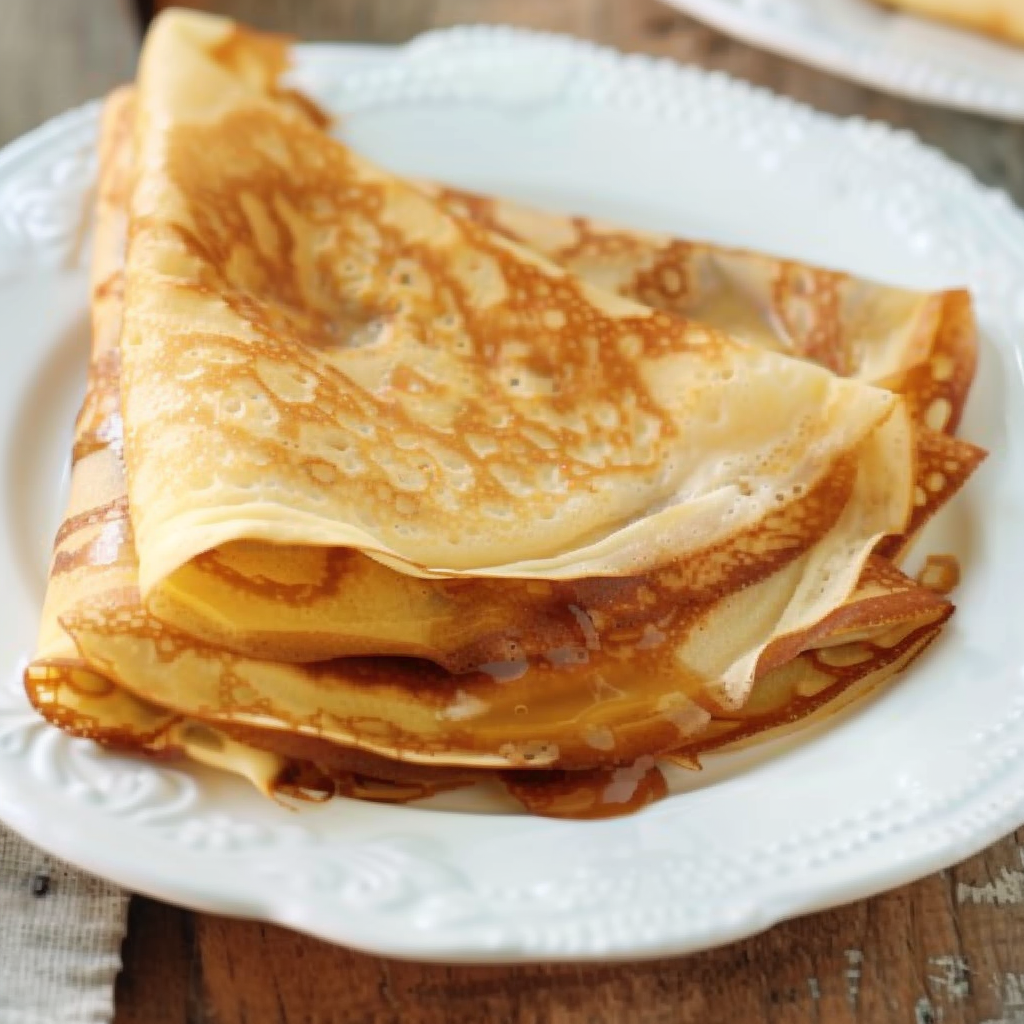
12. FAQs Based on People Also Ask
Are crepes just thin pancakes?
Crepes are similar to pancakes but are much thinner and don’t use baking powder, resulting in a lighter, more flexible texture. Learn about the broader distinction on French cuisine.
Do I need a special pan to make crepes?
Not at all. A good non-stick skillet works fine. However, a dedicated crepe pan can help with even spreading and flipping.
Can you make crepes ahead of time?
Yes. Make and store them in the fridge or freezer. Reheat gently in a pan or microwave to serve.
Why are my crepes rubbery?
This usually happens from over-mixing the batter or cooking over too low heat. Letting the batter rest and using medium heat helps prevent this.
How thin should crepe batter be?
It should be thinner than pancake batter, similar to heavy cream. It should spread easily but not be watery.
Can I freeze homemade crepes?
Absolutely. Stack with parchment between each, seal in a bag, and freeze for up to 2 months.
Is crepe batter better if it rests overnight?
Yes, overnight resting allows flour to fully hydrate, resulting in more tender and flavorful crepes.
Classic French Crepe Recipe How To Make Easy Homemade Crepes
This classic French crepe recipe is the ultimate guide to making thin, tender, and versatile crepes at home. Whether you’re in the mood for a sweet breakfast with Nutella and fruit or a savory brunch filled with ham and cheese, these flawless crepes come together with just six ingredients and a simple method. The batter rests to enhance texture, and each crepe cooks in under two minutes. It’s perfect for layering, rolling, or folding, and can be made ahead, stored, or frozen for convenience. Master this base recipe and enjoy endless filling possibilities.
- Author: Clara
Ingredients
- 1 cup all-purpose flour
- 2 large eggs
- 1 1/2 cups milk
- 2 tablespoons melted butter
- 1 tablespoon sugar (optional, for sweet crepes)
- 1/4 teaspoon salt
- Butter or oil for the pan
Instructions
In a mixing bowl, whisk together flour and eggs.
Gradually add the milk while whisking to avoid lumps.
Add melted butter, sugar (if using), and salt. Whisk until smooth and well combined. Let the batter rest for about 15–30 minutes.
Heat a non-stick skillet over medium heat and lightly grease it with butter or oil.
Pour about 1/4 cup of batter into the pan and quickly tilt and rotate the pan to spread the batter into a thin, even layer.
Cook for about 1 to 2 minutes until the edges begin to lift and the bottom is lightly golden.
Flip and cook the other side for another 30 seconds to 1 minute.
Transfer to a plate and repeat with the remaining batter, greasing the pan as needed.
Serve with your favorite sweet or savory fillings.
Notes
-
For sweet crepes, add the optional sugar to the batter.
-
Resting the batter is key for a smoother texture.
-
Use a non-stick skillet for best results; no crepe pan needed.
-
Make extra and freeze — they reheat beautifully.
-
Adjust fillings for breakfast, lunch, dinner, or dessert.
-
This recipe yields about 10–12 standard 9-inch crepes.
-
For gluten-free or dairy-free options, substitute ingredients as noted.
